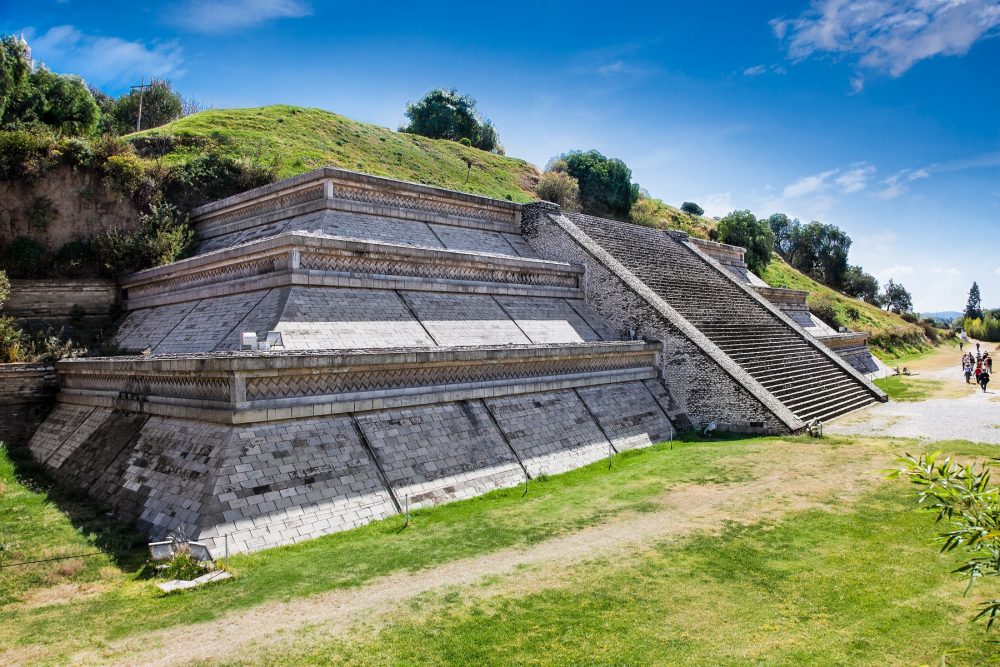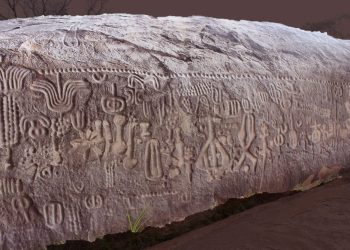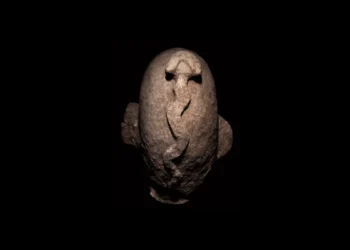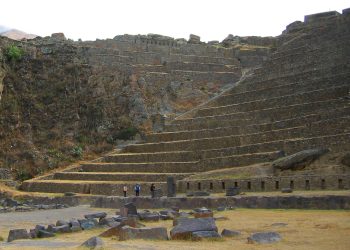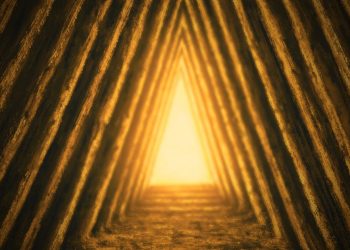Borobudur is considered the world’s largest Buddhist temple. Erected in the ninth century, the massive structure comprises nine stacked platforms, of which three are circular and six are square. A massive central dome tops the platforms. Borobudur is decorated with 2,672 relief panels and 504 Buddha statues. The total area occupied by the reliefs is 2,500 square meters (27,000 sq ft), and they are distributed in the hidden base (Kamadhatu) and Borobudur’s square platforms (Rupadhatu).
Borobudur, Indonesia’s Ancient “Step Pyramid”
The temple—a variation of a step pyramid—is a sanctuary and Buddhist pilgrimage place. The pilgrims’ journey starts at the base of the monument and proceeds along a path that surrounds it while climbing to the top through the three levels of Buddhist cosmology; Kamadhatu (the world of desires), Rupadhatu (the world of forms), and finally Arupadhatu (the formless world).
During the trip, the monument guides pilgrims through stairs and corridors. This ancient pyramid temple is unique. Unlike other ancient temples built on a flat surface, Borobudur was constructed on a hill, 265 meters above sea level and 15 meters above the dry lake surrounding it. The lake’s existence was cause for intense discussions between archaeologists during the twentieth century since it was thought that Borobudur was built on the banks of the lake or even floated on it.
A lotus flower
In 1931, the Dutch artist and Hindu and Buddhist architecture student, W.O.J. Nieuwenkamp, formulated a theory that the Kedu plain was a lake. Borobudur represented a lotus flower floating in it. Lotus flowers are present in nearly all Buddhist works of art, always serving as a throne for Buddha or stupas. The temple’s architecture suggests a lotus design, where the Buddha positions in Borobudur symbolize the Lotus Sutra, present in several Mahāyāna texts. Three circular platforms at the top of the monument represent a lotus leaf.
(Vesak, also known as Buddha Jayanti, Buddha Purnima, and Buddha Day, is a holiday traditionally observed by Buddhists and some Hindus on different days in India, Sri Lanka, Nepal, Tibet, Bangladesh, Indonesia, etc.)
Borobudur; Forgotten and Rediscovered
It is commonly acknowledged that Borobudur was constructed between 750 and 850 by the Shailendra dynasty’s rulers. The name is traced back to the Sanskrit Vihara Buddha Ur, which translates as “the Buddhist temple on the mountain,” although its exact meaning is disputed.
The temple was eventually ‘forgotten’ as evidence points to the fact that Borobudur was abandoned after the fourteenth century with the decline of the Buddhist and Hindu kingdoms in Java and the conversion of the islanders to Islam. After its abandonment, the massive pyramid temple remained hidden for centuries under layers of volcanic ash and jungle growth, like many other pyramids. However, scholars have still not agreed upon the exact cause of its abandonment.
One theory suggests religion had something to do with its abandonment. Theories argue that the temple was abandoned because much of the population was converted to Islam during the 15th century. Another hypothesis suggests the abandonment was due to a famine caused by a volcanic eruption (in the year 1006), which forced the inhabitants to abandon their lands and the monument. Borobudur was rediscovered in 1814 by Thomas Stamford Raffles, the British governor of Java. When Raffles heard about the ancient monument’s possible existence, he sent Dutch engineer H.C. Cornellius to investigate the area.
Cornellius and his men spotted the ancient pyramid temple. Cornellius and his 200 men cut trees, burned vegetation, and dug to clear the monument for the next two months. Due to the dangers of collapse, they could not explore the galleries. Cornellius would eventually report his findings to Raffles, including several drawings. Raffles is credited with focusing the world’s attention on the monument. It wasn’t until 1835 that the temple was completely excavated.
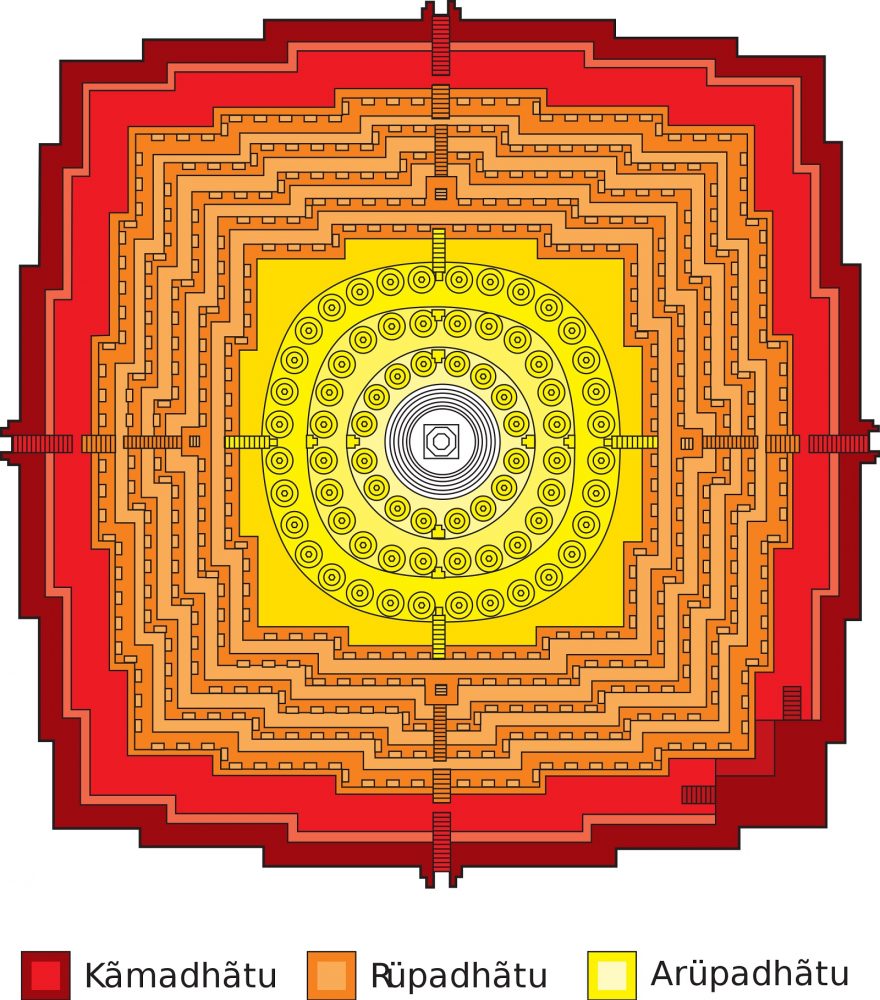
Curiously, like many other ancient structures around the globe, pyramids, for example, have no known construction records or Borobudur’s intended purpose. Despite this, the duration of the temple’s construction was estimated by experts who compared carved reliefs on the temple’s hidden foot and texts used in royal charters throughout the 8th and 9th centuries, concluding that the structure was founded in 800 AD.
Beautiful Design
Borobudur is unique for many reasons. First, the entire step pyramid was envisioned, planned, and eventually built as a massive stupa. When observed from above, it forms a Buddhist mandala, simultaneously representing the Buddhist cosmology and nature of the mind. The base of Borobudur is square, measuring around 118 meters per side. The Pyramid has nine platforms; the lower six are square, and the rest are circular. The upper platforms have seventy-two small stupas that surround a larger one. Each stupa is bell-shaped and decorated with different motifs. There is a statue of Buddha inside each stupa.
Ultimately, it’s a pyramid
Although many of us tend to associate the Pyramids with Egypt, many other monuments and pyramids around the globe are worthy of mention. Although Borobudur was built differently from the Great Pyramid of Giza and had an entirely different purpose, this ancient Indonesian temple is also a pyramid.
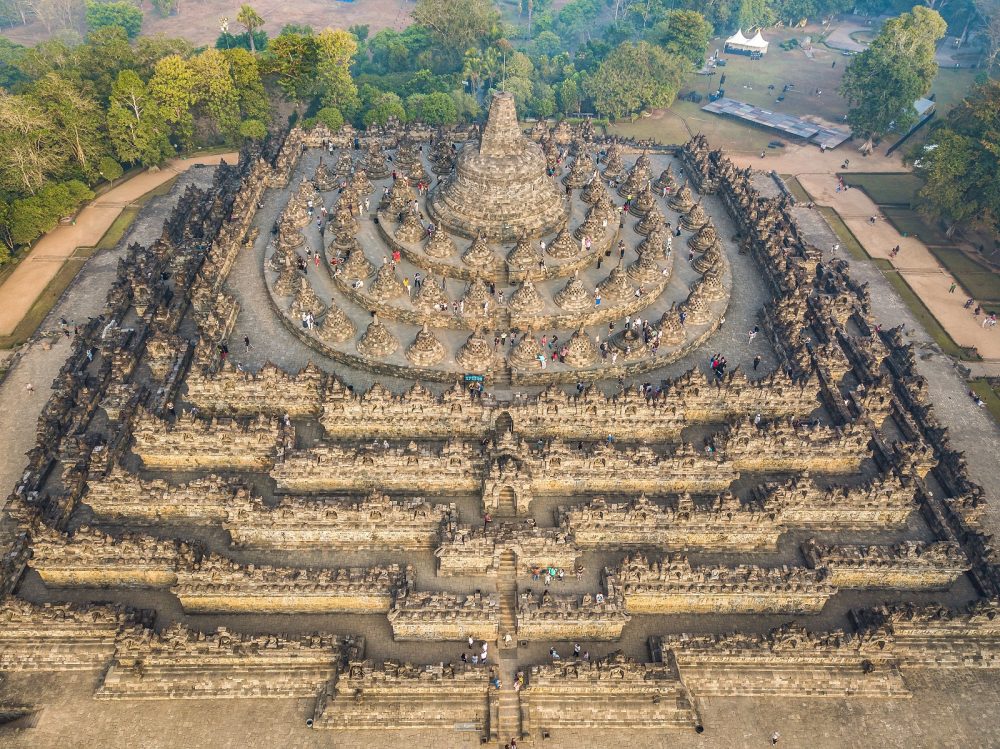
The design of Borobudur is actually a step pyramid. Before the temple was built, ancient cultures built megaliths using earth mounds and stone step pyramid structures. These buildings are called punden berunda and were discovered near Cisolok and Cisolok.
A step pyramid
But the natives of the region did not build pyramids randomly. The pyramid construction was based on the belief that mountains and high places are the abode of ancestral spirits or hyangs. The punden berundak step pyramid contains the basic design in Borobudur and is believed to be the continuation of older megalithic tradition incorporated with Mahayana Buddhist ideas and symbolism. In other words, evolution.
The size of the structure is bewildering. Researchers estimate that more than 55,000 cubic meters of stone were used in the ancient pyramid temple’s construction process. Archaeologists agree that Borobudur’s stones were cut to size, transported to the site, and laid without mortar use. Instead, the temple’s ancient builders used knobs, indentations, and dovetails to form joints between stones. In addition to its bewildering design and shape, the ancient temple builders ensured a complex drainage system to counter the area’s high stormwater run-off. The builders installed as many as 100 spouts at each corner to prevent the temple from flooding.
Architectural configurations
The temple itself differs greatly from the general design of other constructed temples serving the same purpose. Borobudur wasn’t built on a flat surface but a natural hill. Despite this, the building techniques are simar to other temples in Java. Borobudur features no inner space, and the temple is viewed as a pyramid in terms of design.
Although different in design from Egypt’s pyramids, Borobudur is a specific kind of Pyramid, serving a particular purpose, unlike the Egyptian pyramids, which archeologists argue were used as ancient tombs to house the remains of the Pharaoh. Numerous scholars and authors have described Borobudur in several ways, including a pyramid, a sacred mountain, a stupa, and a shrine. The temple features details, including all four previously mentioned architectural configurations. But most impressively, when viewed from the air, the entire structure reveals its glorious design, that of a three-dimensional mandala.
Join the discussion and participate in awesome giveaways in our mobile Telegram group. Join Curiosmos on Telegram Today. t.me/Curiosmos






